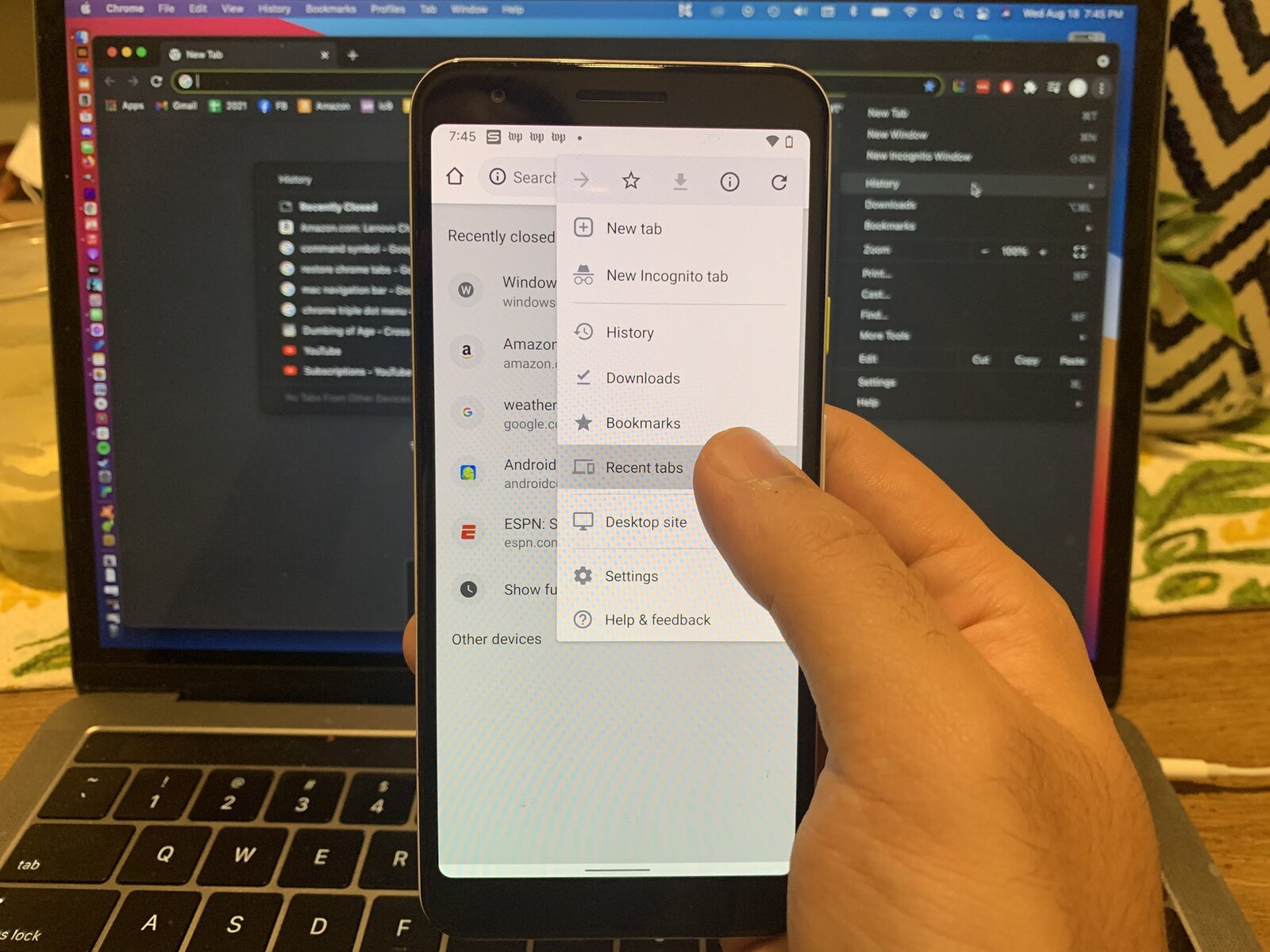Introduction
Losing track of important tabs while browsing can be a frustrating experience, especially when you have multiple tabs open for research, work, or leisure. Whether it's due to an accidental closure, a browser crash, or a sudden system shutdown, the disappearance of tabs can disrupt your workflow and lead to a sense of disarray. Fortunately, Google Chrome, the popular web browser for Mac users, offers several methods to restore closed tabs and regain access to your browsing history.
In this article, we will explore three effective methods to restore tabs on Mac Chrome. Each method is designed to cater to different scenarios, providing you with the flexibility to choose the most suitable approach based on your specific browsing habits and preferences. By familiarizing yourself with these methods, you can effortlessly retrieve closed tabs and seamlessly resume your browsing sessions without missing a beat.
So, whether you accidentally closed an important tab, experienced a sudden browser crash, or simply want to revisit a previously viewed webpage, this guide will equip you with the knowledge and techniques to effortlessly restore tabs on Mac Chrome. Let's dive into the methods and discover how you can reclaim your browsing history with ease and efficiency.
Method 1: Using the History Menu
When you accidentally close a tab or need to revisit a webpage from your browsing history, the History menu in Google Chrome becomes a valuable tool for restoring tabs on your Mac. This method is particularly useful when you remember specific keywords, phrases, or the approximate time when you accessed the tab you want to restore.
To access the History menu, you can either click on the "History" option in the top menu bar or use the keyboard shortcut "Command + Y." Once the History menu is open, you will find a list of options, including "Show Full History," "Open All History," and "Recently Closed." Clicking on "Recently Closed" will reveal a dropdown list of the tabs that you have closed during your browsing session.
If you closed multiple tabs simultaneously, you can restore them all at once by selecting the "Reopen All Windows from Last Session" option. This feature is especially handy when you want to restore an entire browsing session, including all the tabs and windows that were open before the browser was closed.
Furthermore, the History menu allows you to search for specific websites or pages by entering keywords in the search bar. This functionality is incredibly useful when you need to quickly locate a particular tab from your browsing history without manually scrolling through a long list of closed tabs.
By utilizing the History menu in Google Chrome, you can efficiently restore closed tabs and seamlessly navigate through your browsing history. This method empowers you to regain access to important webpages, research materials, or unfinished tasks, ensuring that your browsing experience remains uninterrupted and productive.
In summary, the History menu in Google Chrome serves as a reliable resource for restoring closed tabs on your Mac. Its intuitive interface and search functionality enable you to effortlessly retrieve specific tabs from your browsing history, providing a seamless and efficient way to manage your web browsing sessions.
Method 2: Using the Recently Closed Tabs Menu
When it comes to restoring closed tabs on Mac Chrome, the "Recently Closed" tabs menu emerges as a convenient and efficient tool. This method is particularly beneficial when you need to quickly recover tabs that were recently closed, without the need to navigate through extensive browsing history. Whether you accidentally closed a crucial tab or want to revisit a webpage you were previously viewing, the "Recently Closed" tabs menu simplifies the process of tab restoration.
To access the "Recently Closed" tabs menu, you can simply right-click on an empty area of the tab bar or use the keyboard shortcut "Command + Shift + T." This action triggers the display of a dropdown list containing the tabs that were closed during your browsing session. Each entry in the list represents a closed tab, allowing you to selectively restore specific tabs based on your current needs.
Furthermore, the "Recently Closed" tabs menu provides a convenient overview of the tabs that were closed across different browser windows. This feature is particularly useful for users who frequently work with multiple windows and need to restore closed tabs from various browsing contexts.
In addition to individual tab restoration, the "Recently Closed" tabs menu offers the option to restore all closed tabs from the current browsing session. By selecting this option, you can efficiently recover all the tabs that were closed, ensuring that you regain access to your complete browsing session without the need to manually reopen each tab.
Moreover, the "Recently Closed" tabs menu retains a chronological order of closed tabs, allowing you to easily identify and restore tabs based on their closure sequence. This functionality is valuable when you need to recover tabs in the order they were closed, enabling a seamless transition back to your previous browsing state.
By leveraging the "Recently Closed" tabs menu in Mac Chrome, you can swiftly restore closed tabs and seamlessly resume your browsing activities. This method empowers you to efficiently manage your tab restoration process, providing a user-friendly and intuitive approach to recovering closed tabs without unnecessary complexity.
In summary, the "Recently Closed" tabs menu in Mac Chrome serves as a valuable resource for restoring closed tabs, offering a streamlined and accessible method to retrieve recently closed tabs and maintain a seamless browsing experience.
Method 3: Using the Chrome Sync Feature
Utilizing the Chrome Sync feature to restore tabs on Mac Chrome offers a seamless and efficient way to synchronize your browsing data across multiple devices. This method is particularly advantageous for users who rely on Chrome's synchronization capabilities to seamlessly access their browsing history, bookmarks, and preferences across different platforms.
To leverage the Chrome Sync feature for tab restoration, ensure that you are signed in to your Google account within the Chrome browser. Once signed in, Chrome Sync automatically synchronizes your browsing data, including open tabs, across all devices where you are logged in with the same Google account.
When you encounter a situation where you need to restore closed tabs on your Mac Chrome that were originally accessed on another device, the Chrome Sync feature becomes invaluable. By accessing the synced data from your Google account, you can effortlessly retrieve the closed tabs from your browsing history, regardless of the device on which they were originally opened.
To access the synced tabs on your Mac Chrome, click on the profile icon in the top-right corner of the browser window. From the dropdown menu, select "Other Devices," which will display a list of devices where you are signed in with the same Google account. By clicking on a specific device, you can view the tabs that are currently open on that device and seamlessly reopen them on your Mac Chrome.
Furthermore, the Chrome Sync feature ensures that your browsing history and open tabs are continuously updated and synchronized across all your devices in real time. This means that any tabs closed on one device will be reflected in the synced data, allowing you to restore them on any other device where Chrome Sync is active.
In addition to tab restoration, Chrome Sync offers a comprehensive synchronization of browsing data, including bookmarks, passwords, and browser settings. This holistic synchronization approach ensures a consistent and personalized browsing experience across all your devices, enhancing convenience and productivity.
By leveraging the Chrome Sync feature, you can seamlessly restore closed tabs on your Mac Chrome, regardless of the device where they were originally accessed. This method exemplifies the power of cross-device synchronization, providing a unified browsing experience and ensuring that your important tabs are always accessible, no matter which device you are using.
In summary, the Chrome Sync feature in Mac Chrome serves as a robust and reliable tool for restoring closed tabs, offering seamless synchronization of browsing data across multiple devices and empowering users with effortless access to their browsing history and open tabs.
Conclusion
In conclusion, the ability to restore closed tabs on Mac Chrome is a valuable feature that enhances the browsing experience and mitigates the frustration of accidental tab closures or browser crashes. Through the methods outlined in this article, users can effectively retrieve closed tabs and seamlessly resume their browsing sessions with ease and efficiency.
By utilizing the History menu, users can access a comprehensive list of closed tabs and browsing history, enabling them to selectively restore specific tabs based on keywords, timeframes, or entire browsing sessions. This method provides a versatile approach to tab restoration, catering to diverse browsing habits and preferences.
The "Recently Closed" tabs menu offers a convenient and streamlined way to recover tabs that were closed during the current browsing session. With the ability to restore individual tabs, all closed tabs, or tabs from different browser windows, this method simplifies the process of tab restoration and ensures that users can swiftly regain access to their browsing history.
Furthermore, the Chrome Sync feature exemplifies the power of cross-device synchronization, allowing users to seamlessly access their browsing data, including closed tabs, across multiple devices. This method ensures that important tabs are always within reach, regardless of the device being used, and underscores the convenience and flexibility offered by Chrome's synchronization capabilities.
In essence, the methods for restoring tabs on Mac Chrome not only provide practical solutions for recovering closed tabs but also contribute to a seamless and uninterrupted browsing experience. Whether it's retrieving crucial research materials, revisiting informative webpages, or resuming unfinished tasks, the ability to restore closed tabs empowers users to maintain productivity and continuity in their online activities.
As users continue to navigate the digital landscape and engage in diverse online pursuits, the knowledge and utilization of these tab restoration methods serve as valuable tools for optimizing the browsing experience. By incorporating these techniques into their browsing routines, users can navigate through the dynamic web environment with confidence, knowing that their closed tabs are readily accessible and their browsing history is effortlessly managed.
Ultimately, the seamless restoration of closed tabs on Mac Chrome reflects the commitment to user-centric design and functionality, ensuring that users can navigate the web with ease and efficiency, free from the disruptions caused by accidental tab closures or browsing interruptions.

























